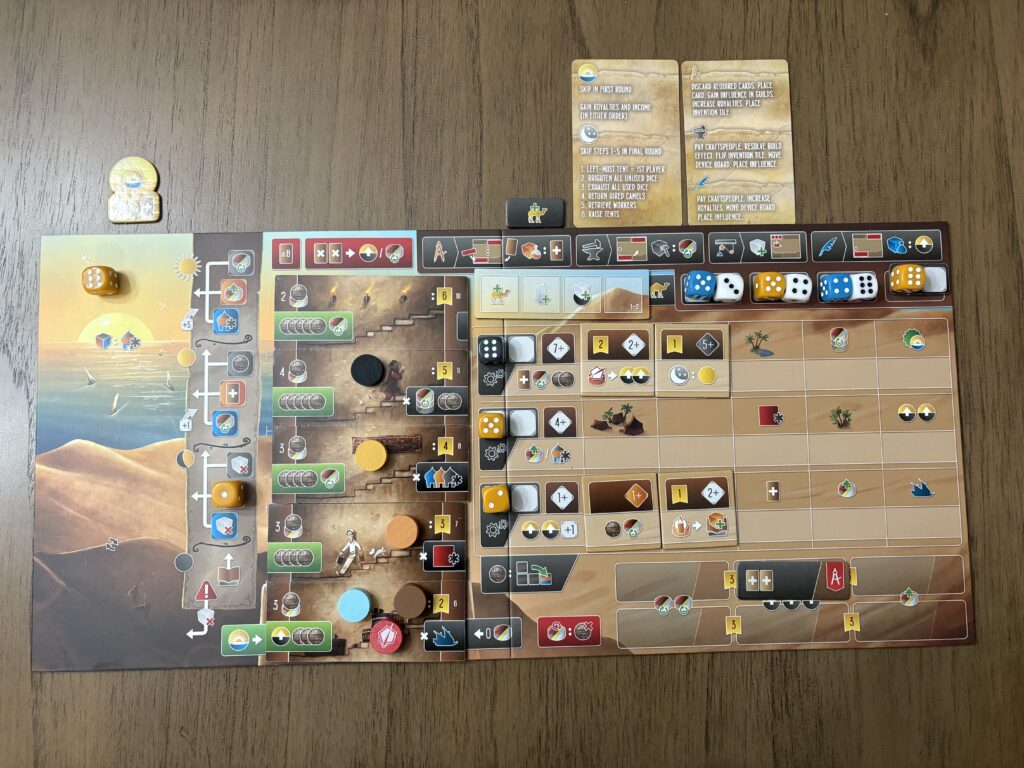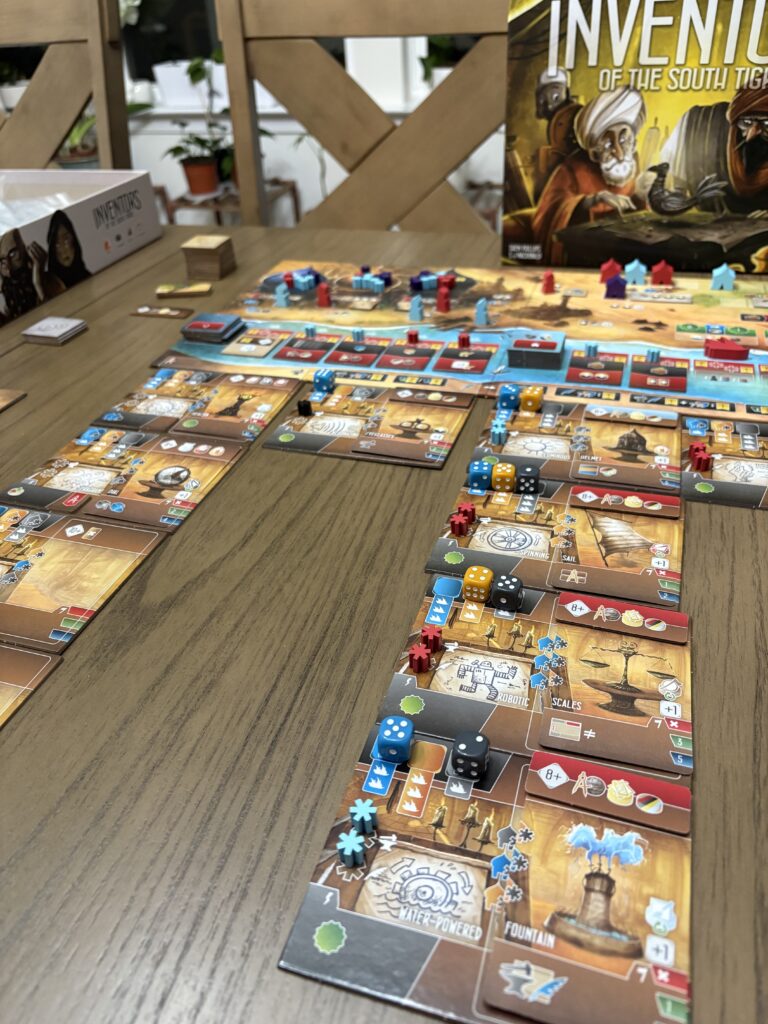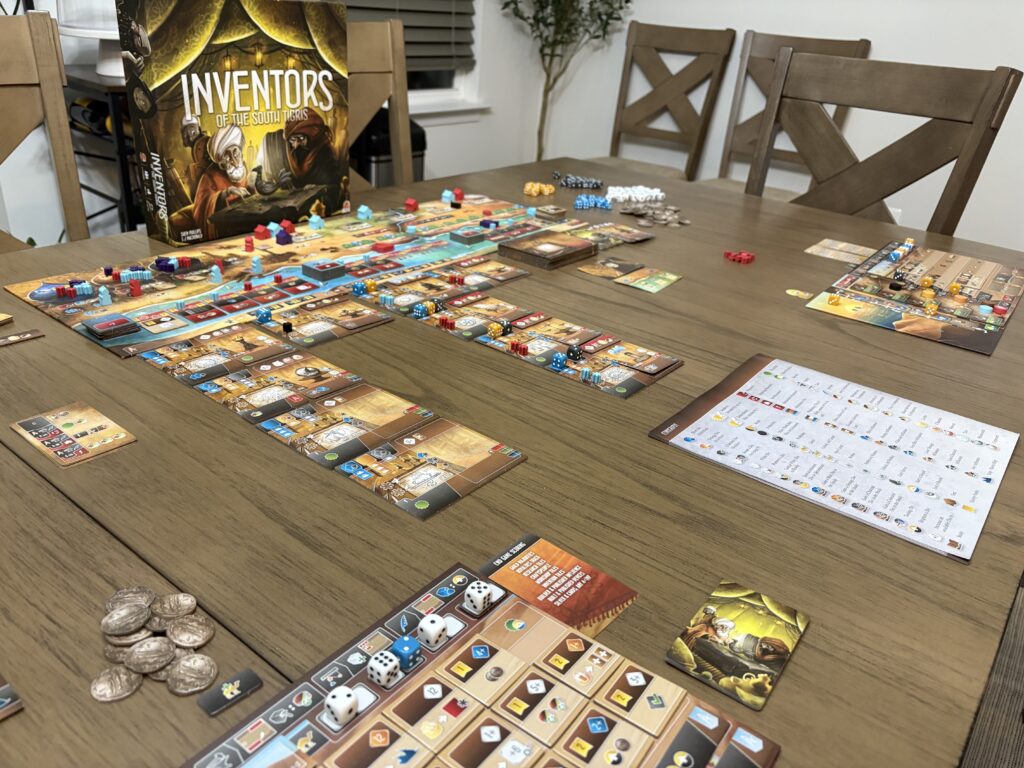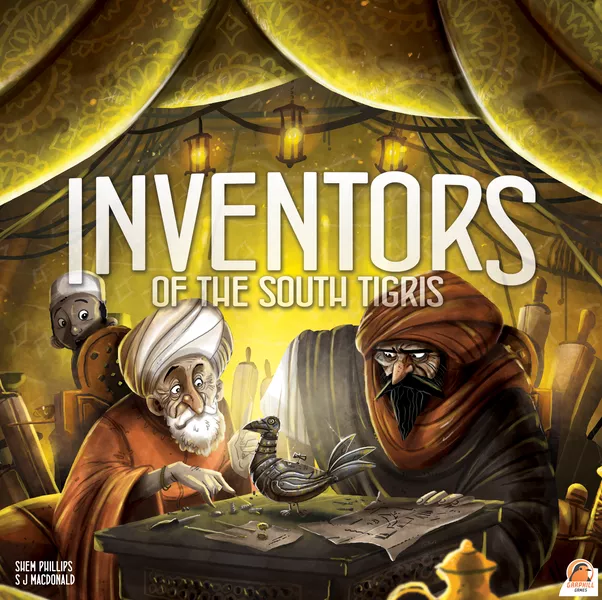Welcome to this week’s review! This week I’m discussing the third game in the South Tigris trilogy from Garphill Games and my most recent unboxing (here). So without further ado, let’s jump into my thoughts.
Disclosure: A review copy of this game was provided to The Meeple Digest in exchange for an honest, unbiased review. This review is not intended to be an endorsement.
Inventors of the South Tigris
- Designers: S J Macdonald, Shem Phillips
- Publisher: Garphill Games
- Complexity: Heavy
- Time: 90-120 Minutes
- Players: 1-4
- Main Mechanisms: Dice/Worker Placement
Inventors of the South Tigris is the third and final game in the South Tigris trilogy from Garphill Games. If you missed my previous reviews of the two other games in the South Tigris series, Wayfarers and Scholars, you can check them out here and here. Due to the nature of Inventors being the last in the trilogy, I will be comparing it against the other two in the series.

Let me preface that while all three games in the trilogy share similar DNA, namely using dice for worker placement, each one is unique in its own way. In Wayfarers, players build up a tableau of cards and modify/upgrade their dice; whereas in Scholars, players translate scroll cards from ancient languages and use the color wheel with dice in interesting ways. In Inventors, as the name suggests, players primarily focus on inventing, building, testing, and publishing devices.
As the heaviest game of the three, there’s plenty more players have to be concerned with, but let’s start with the devices themselves, as they are the most unique and interesting part of the game. To invent a device, players will play a device card from their hand on top of a device board, combining the two. Each of the device boards and cards are named, and you can end up with some funny combinations like a folding boat or trick scales.
In Scholars, I liked that the game offered opportunities for positive player interaction, largely by using other players’ translators. In Inventors, the player interaction has been bumped up to another level. For example, one player could invent a device, while another builds it, and another publishes it. I like this level of player interaction, as I’m always interested in what other players are inventing, building, etc.
There are also quite a few elements to consider when choosing which devices to invent, but probably the most important part is that each device card offers end-game scoring opportunities based on the player meeting certain conditions. Both the builder and the publisher get to score for that device card, and if the same player is both the builder and the publisher, they get to score it twice. This increases player interaction because if another player invents a device, maybe that end-game scoring condition matches up nicely with my strategy, so I’ll go ahead and build the device. Don’t worry, this is mostly all positive player interaction because even if you don’t get to build the device you invented, you’ll still receive some benefit.
The second big element in the game is the workshop tiles. When players test a device, they will get to move their ship along a track and collect workshop tiles that can be added to one of three different rows on their player board. In addition to using dice to interact with the devices, dice can also be used to activate one of three workshops, triggering all tiles in that row. To gain the benefit of each tile, tiles will have a condition that has to be met, for example, the dice value has to be at least this number and/or a certain color dice has to be used. In the most recent game I played, I focused heavily on moving my ship along the track, collecting a bunch of workshop tiles, and triggering my three engines, which was incredibly satisfying. This also adds some alternative paths to victory besides just focusing heavily on the device workflow.

There’s plenty more mechanisms in Inventors, but the last one I’ll touch on are the craftspeople. Each player has six different colored craftspeople that will mostly be used when building and publishing devices. For example, building a device will require the player to activate three specific craftspeople. When a craftsperson is used, they are inactivated (flipped) and will have to be activated again before they can be used. Also, whenever a craftsperson is used, they progress up one level in that player’s tower (there are ten levels in total). As craftspeople progress up, they will become more expensive to use, but whenever all six craftspeople have been moved up a level, that player will get an immediate benefit, and it also increases their income between rounds. There are also points to be scored at the end of the game based on what level each craftsperson is on. I enjoy this mechanic of managing and progressing my craftspeople up my tower, and it also adds more things to consider when deciding which device to invent, build, and publish.
In terms of the amount of variety or different paths to victory, Inventors likely falls in the middle between Wayfarers and Scholars. In Wayfarers, each game feels different because of the amount of options with modifying/upgrading dice, as well as all of the cards that can be added to your tableau that can open up more action spots. In contrast, Scholars felt more focused, pick scroll cards that synergize well and then work out how to translate them. Inventors falls somewhere in the middle between the two. While all of the workshop tiles and devices are unique, they are mostly variations of one another, and while each game will be different in which areas you focus on more, it doesn’t feel quite as open as Wayfarers. This is not necessarily a negative aspect of the game, it’s more so that I feel like each game caters to a different type of player making each game stand out from one another.
Inventors also comes with a very easy to pilot solo mode. Each turn, you flip over a card for the AI from a deck and carry out either the top or bottom action. While more random than a human player, the AI will still invent, build, publish, and test devices to ensure the display of devices never becomes too stagnant.
Finally, like Scholars, the game comes with a shorter version by shortening the game down from four to three rounds. To make up for the loss of a round, each player also gets a goal card that rewards the player by meeting certain objectives throughout the game. The rules encourage players to use the three round version when teaching the game to new players, and I wish more games tried something like this. The last thing new players want to do is sit through a long game while they’re still figuring out the rules. While I’ll likely always play using the full four rounds with experienced players because I think it balances out the strategies a bit more, I’m still glad the three round variant was included.

I’ve been hinting at this throughout the review, but if you can’t tell, Inventors is by far the heaviest/most complex of the three games. To keep this review a bit more digestible, I haven’t included gaining/brightening dice, worker placement spots, research tiles, end of round tents, and more. As readers are probably aware, I’m not one to shy away from a heavy game, which make up a big part of my collection. However, this game toes the line for me on how complex a game should be, while still being enjoyable.
It probably didn’t help that my first couple games of Inventors were solo, as I was still trying to both learn the rules while also piloting an AI. After more plays, things started to click, and I didn’t need to reference the rules as much. The game does come with player reference aids, and the boards provide some iconography to help remember certain rules, but I do wish the player aids included were a bit more detailed as they are more of a memory jogger than ones to rely on. There’s also a ton of iconography, particularly on the workshop tiles and device cards that I constantly had to reference in the rulebook. Due to the general complexity of the game and the number of moving parts, I worry about how easy it will be to pull this one out after some time on the shelf. Overall, I really do enjoy the mechanisms in Inventors, but I do wonder if certain aspects of the game could have been streamlined.
As with nearly any game with dice, there will be some element of luck involved. In Wayfarers, I liked how you were able to modify your dice using the upgrade tiles. In Scholars, not all actions required high numbers on dice, and rolling low never felt too punishing. In Inventors, there’s still ways to modify low valued dice, but it does feel more punishing than in either of the other two games. Having higher numbered dice will always allow you more choices and freedom than if those same dice were low numbers. There are still ways to modify dice, but if one player has to spend cards or actions to do so, while another player doesn’t, then it can feel discouraging.
Finally, I mentioned that I enjoyed the player interaction with the devices, but the level of interaction will vary based on different player counts. In a three- or four-player game, there are sure to be more devices invented, built, published, and tested, leading to plenty of player interaction. However, with only one or two players, naturally there will be less devices to interact with. Of course, the tradeoff for that increased player interaction is a longer game, and even a two-player game with experienced players was taking around two hours to complete. The sweet spot for this game is likely at three players because there will still be plenty of interaction without the game stretching too long.

Overall, I really enjoyed my plays of Inventors of the South Tigris, and while each game in the trilogy has some shared mechanisms, each manages to still feel unique and stand on their own. I still need to revisit Wayfarers before I’m able to do a proper ranking of the three games. However, due to their differences, each game will likely have its fans depending on a player’s tastes in games. If you’re new to the South Tigris series, I’d recommend starting with either Wayfarers or Scholars first, but if you’ve already played either of those, then I’d definitely recommend checking out Inventors.
With that, I’ll wrap up this week’s review! I’d love to hear your thoughts on any of the games I’ve mentioned or future content suggestions in the comments below. Happy gaming!
If you liked this post and want to be notified when new content is released, then follow me on Instagram @themeepledigest.
